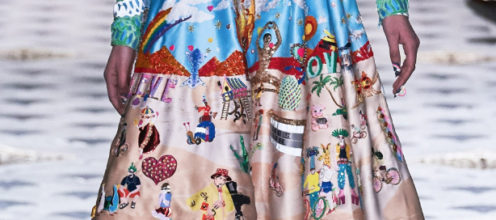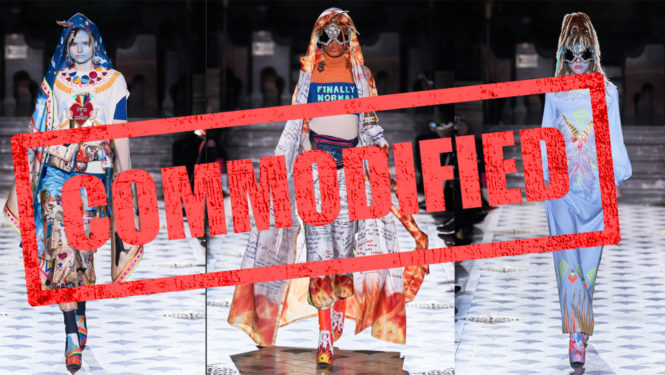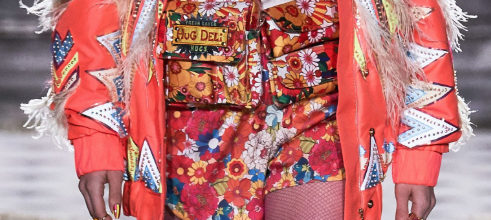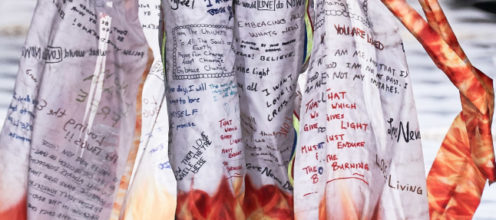Manish Arora, six-time Burner, held a runway fashion show influenced by Burning Man during Paris Fashion Week.
A good portion of the collection are gorgeous, bold, beautiful pieces.
You could make the argument that the goggles, fur, etc. were examples of cultural appropriation. But that is a silly argument. Burning Man *wants* its culture to be appropriated. We want our culture to spread into the world. And while we shun feather war bonnets on Participants, we embrace appropriation in many other forms of expression. Even our sacred Temples borrow heavily from other traditions.
But 14 pieces in the collection are troubling.
For example, he created a fabric print using an illustration of the Playa with many recognizable Playa landmarks and art.

He then used this fabric for dresses and pants.
There are also handbags that are replicas of known mutant vehicles. And even a “Hug Deli” fanny pack.
This clearly violates the Decommodification Principle, doesn’t it?
Burning Man culture has literally been turned into a product.
As soon as I saw the Vogue slideshow, I got online and lost my cool.
One of the first questions that came up in comments was, “Did he ask for permission from the artists?” I spoke to several artists represented on the fabric. Yes, they were contacted by a representative of Manish but they responded with very clear, “No, you may not use it.” Ewwww.
But, by far, the most disturbing piece is the LampLighter/Temple outfit.
It looks like a Lamplighter robe, and then has writing scrawled all over it. Those words, presumably, are taken from our sacred Temple. Even if it is just a facsimile of writing that *looks* like it is taken from the Temple, it is pretty darn crass. Maybe even blasphemous?
I know it is a little silly for a culture with such a rich history of attacking sacred cows to get culturally vegan when it comes to our own iconography. But it just feels so wrong? It would be like taking photos of people privately crying at a funeral and then printing their faces on t-shirts.
If we dig deep, maybe this is a poetic opportunity for our community to feel what other cultures and faiths must feel like to see their sacred things disrespected. But mostly it just feels gross.
On the upside, passionate conversations are happening all over Facebook, email lists, message boards and bar stools about this saga.
Click Here for a transcript.







Instagram models are here to stay. Same with the plug n play camps. It’s all you burnier-than-thou types that try to stop the evolution of the event. Stop telling people how they’re burning wrong. Most of you are kissless virgins, anyway. Try moving out of your mothers’ basements. And stop sniffing her panties.
Report comment
You don’t think The Principles are relevant any longer?
Report comment
The principles were written by a junkie high on blue flake cocaine and ego. We don’t need them anymore. The time is now to make as much money as we can off this event. Everyone else is doing it.
Report comment
That your name is “Chad” is perfect.
Report comment
That’s what your wife said after she was done gargling my cum.
Report comment
Many philosophers have said in different forms… “Offense is a choice you make”
If you choose to be offended one approach you can try is to take a breath, inspect those reasons, take ownership, and carefully articulate *why* you took offense, rather than lazy conversation peanut butter words such as “gross”.
It may help you find the core of your feeling as it relates to your values, and more importantly your expectation of other’s values and behaviors.
It seems the essence of this particular issue is: “a person who I believed shared my value system didn’t behave in a way that conformed to those values”. Perhaps a good place to start working. Go forward with love!
Report comment
I think there is value to offense…an establishing what is and isn’t okay.
Is it okay to leave your trash at Burning Man? No, it is against the Principles.
Is it okay to commodify Burning Man? No it is against the Principles.
I believe it matters.
As far as being offended by blasphemy of the Temple use. I agree that is a choice. But it does affect the relationship that people have with the Temple when they fear their expressions there will not be respected. Burning Man is a safe place for expression that allows people to bloom. The Temple is a safe place for grief and it allows a different kind of growth and healing. Perhaps I don’t have the vocabulary, but anything that reduces the power of of community to help people express or heal, to me, is gross.
Report comment
I think we have to use some subtlety here. I am not concerned that a designer used Burning Man art as inspiration. Fashion is a commodity but it is also an art. Artists sell their work when they can. Turns out they need to eat if they are to continue to produce art. Truth is Beauty sits outside a casino is Vegas and that’s great. More people get to experience that beautiful piece and it will be preserved for a long time. That can be someone’s inspiration to learn more about Burning Man and for our culture to reach and influence a wider audience. Which is something we want to do, right? That’s different than using someone’s art without permission, which I think is the crime here.
Report comment
I think the two big concerns are the sanctity of the messages left in the temple and the rights of the artists being infringed.
When we fear that messages we inscribed in the temple as a part of our spiritual growth, healing, or transformation are being commodified then will we write our deepest thoughts and truest feelings? Thoughts we want transported away with the fire? Or will we be afraid our comments will end up on 10,000 ass bags.
When the fashion designer uses clear images of our art without clear permission and license, what gives him the right to profit off the backs and work of the artists who’s work he’s using. Truth is Beauty is in Las Vegas, under proper agreements with her creators. The art car the mantis is also on permanent display also with proper agreement with its creator. This issue is not different in that the artists that created the original inspired works are due compensation, and if they were originally asked and said no to this use, they are entitled to restitution as well.
The .org protects the use of the “burning man” trade marks very aggressively, and maybe in this instance they should assist the artists in filing a class action to protect the tights or the artists that contributed to the community.
Report comment
“Chad” is just an internet troll and is best ignored.
The bigger point here is that someone is using other people’s intellectual property to create commerce or commercial art. At its simplest, purest form, it’s piracy.
Nothing in Burning Man is absolute. How many of us had muttered “thanks, Larry” in the same thought where we call Burning Man “Uncle Larry’s Dirt Rave? (or something like that).
The instinaces of deviting from the 10 Principles aren’t necessarily the problem – they’re contradictory, they don’t always make sense, they’re vague, they’re guidance, not canon – but the increasing volume and boldness of them are the problem. I believe the more people see of Burning Man being commodified, the more they’ll think it’s OK; or, maybe they will assume a relaxed application.
As with many problems, it’s an opportunity to do better. If Burning Man can get people to think twice about commodifying – or, if applicable, what it means to commodify – then perhaps it will have reach beyond Burning Man. Maybe people will put their smart devices down and pay attention to what is immediately around them.
That’s sort of a tangental thing; commodificaiton is a symptom of greater societal problems. Social media is not a good thing; it doesn’t bring us together, it pulls us apart and turns us into products. Commodification of Burning Man imagery, culture, identity is a sympton.
This isn’t the first big challenge Burning Man has faced, and it won’t be the last.
Report comment
BMORG did this to themselves, they didn’t care for all the years they were getting complaints from camps. It’s LITERALLY document in the BRC newspaper go back the many years and you can pinpoint when it started. NOW all of a sudden BMORG cares about all the ‘principals’ PLEASE! BMORG made their bed and they can lie in it.
Report comment
He might have asked some, but certainly didn’t ask all of the artists whose work is shown. I never received an email or anything from him or his team, so I’m very surprised, and horrified, to find one of my sculptures on a skirt. I would never agree to my art being used for a fashion line, let alone a high-profile runway collection.
Report comment
Hi Halcyon, Thank you for you editorial. The drawings the designer used are ‘drawings’ and are different in degree, not in kind, from other artists who make paintings on the playa, and as inferred above, artists who have accepted donations from many of us but who still need to sell their work and sell it to a commercial venue. After reding all of this and Megan’s Post I was remembering how renown artist Guillermo Gomez Pena dismissed Burning Man to me in a conversation many years ago because of its exploitative and ultimately colonial practice of commodifying other cultures’ religious and aesthetic material. I argued it was homage and evolution. He also made a comment at the time on its cowboys and Indians camps, and -what he called- fake tribalism. I find the tirade against the designer pretty hypocritical given there are many people who make a living from direct references or materials that reflect, evolve, or derive from images of art and people on the playa. If a drawing of an artwork is the intellectual property of the artist, then we are going down a very slippery slope that also includes not being able to play music in bars out there that is the intellectual property of musicians, or more often, the corporations that own their work, without paying for it, and more. Intellectual property is the Ouroboros of capitalism and mostly a privilege of white people. And are you not a little concerned the community is calling out the brown dude for this when so many white others have earned income for their work? I find this interestingly exemplar of the unconscious bias inherent in our community that I hope we may soon evolve away from. You’ve mentioned it but have not in my opinion, given that concern it’s due. I recognize I need to clean my own house before I fling invective and shade at another.
Report comment
The playa is inspirational, and it should be. But there is a huge difference between taking your experiences, and using it to create your own art, and taking images from other people’s efforts, repackaging it, and selling it. I don’t even care if it’s technically legal ie, he drew “Hug Deli” instead of using a photograph,
He has crossed an obvious line in disrespecting the people who actually create beauty on the playa. He did not have the creator’s permission to reuse their art (in many cases). he gave no credit to the original artists even when he did, and he stands to personally profit from this. This is not being inspired by the playa, it is appropriating it.
He actually used the man’s head and other iconography of the event that is clearly protected IP.
So he violated the principles, trademark law, and basic respect between artists.
SMH
Report comment
Here’s an open question to the community: If I were to go to D.C. and take a rubbing of the Vietnam wall, and then make a print out of it which I sew into pants…is that respectful? Is it unethical?
I think there’s a spectrum here rather than a line. For example, if the pants were part of a museum exhibit to highlight the atrocities of the Vietnam War…maybe OK. I’ve seen parts of the AIDS quilt used that way, and I feel OK about it. On the other hand, I think if someone made a cape out of the Vietnam wall or the AIDS quilt and then started selling it for $800 at Macy’s there would be a massive public outcry. Maybe the AIDS quilt is a better parallel here because it has been represented on items and in photos, and it is the artistic memorial of a specific community of people. If I’m wearing the AIDS quilt cape to the oscars as a custom piece to promote awareness of the community of people affected by the disease, maybe that’s OK…but is it OK to put the cape on a model in a for-profit show that is titled, “Ready to Wear”? What if it ends up sold at a mall? I’m feeling an overwhelming sudden need to copyright my AIDS memorial quilt piece…
Report comment
Here’s an open question to the community: If I were to go to D.C. and take a rubbing of the Vietnam wall, and then make a print out of it which I sew into pants…is that respectful? Is it unethical?
I think there’s a spectrum here rather than a line. For example, if the pants were part of a museum exhibit to highlight the atrocities of the Vietnam War…maybe OK. I’ve seen parts of the AIDS quilt used that way, and I feel OK about it. On the other hand, I think if someone made a cape out of the Vietnam wall or the AIDS quilt and then started selling it for $800 at Macy’s there would be a massive public outcry. Maybe the AIDS quilt is a better parallel here because it has been represented on items and in photos, and it is the artistic memorial of a specific community of people. If I’m wearing the AIDS quilt cape to the oscars as a custom piece to promote awareness of the community of people affected by the disease, maybe that’s OK…but is it OK to put the cape on a model in a for-profit show that is titled, “Ready to Wear”? What if it ends up sold at a mall? I’m feeling an overwhelming sudden need to copyright my AIDS memorial quilt piece… Is this comparable or is the temple writing somehow different?
Report comment
This seems like a blatant publicity stunt. The weight of this collection is about lifting someone’s art and shortcutting it into a novelty fabric. In the end it says volumes of disrespect and blatant disregard toward a community which upholds trust as a sacred tenant. Hopefully the funders, supporters, designer and team of this “collection” find time to pause and consider the meaning of design artistry and having little integrity is a large part of their message.
Report comment
The irony is that printing a custom fabric is a tactic to prevent “fast fashion” copies.
Double irony that very few burners are going to spend his prices on ready to wear.
Luxury commodifies luxury.
The price to print and manufacture is going to be far less than $150, and the price >10x.
That’s what we call profit.
If burners have a large supply of excess cash, there are burners who love to sew original wear in any art city.
Report comment
It’s sad that Mr. Arora ignored the 10 Principles.
Since Mr. Arora attended the event did he violate Burning Man Ticket Terms and Conditions or do they only apply to the event? How about if Mr. Arora does not sell but rather gifts his products? Or he sells his products solely for the purpose of supporting an art installation, or camp, or performances, or provides other benefits directly to the Burning Man community?
An inquiry of the Burning Man website by someone at Mr. Arora’s company would have found this information under Trademarks & Copyrights, Protecting Burning Man and Our Community:
“Q: Can I make a t-shirt (necklace, poster …) that includes “Burning Man” (“Black Rock City,” The Man symbol, pictures from Burning Man …)?
A: This is generally OK if the item is shared as a gift. Gifting is one of Burning Man’s Ten Principles. The Burner community is actually encouraged to incorporate the Man symbol, other Burning Man symbols, or images obtained at the event into artwork and other “swag” for gifting purposes.
You cannot, however, use Burning Man’s trademarks, copyrights, or images from the event on promotional materials for your company, or on items offered for sale. This includes online peer-to-peer resale spaces, such as eBay or Etsy. This also means that if you leave Black Rock City with ungifted gifts, you cannot sell the leftovers (even at, or below, the cost of making these items). While we sympathize with everyone’s need and desire to have sufficient funds to create and gift the art and items that make our culture and event so unique, it would be a slippery slope if such items could be sold because they were left over after others were given away.
Playa-focused gifting projects (such as art installations or theme camps) using crowdfunding tools like Indiegogo or Kickstarter have Burning Man’s permission to gift items in their fundraising campaigns that incorporate the Man logo, other trademarks or copyrights, or photos from the event into their own designs. Some examples include:
OK!
Gifting medallions or t-shirts that incorporate “Black Rock City”
Gifting a sticker with your art project logo that incorporates the Burning Man symbol in appreciation for a $15 donation to the project’s Kickstarter campaign
NOT OK!
Selling earrings with the Burning Man symbol on Etsy
Printing a company name or web address on your gift items”
Report comment
I’m still hoping to hear why BMORG’s treasurer Jennifer Raiser supported this project.
The BMORG is squarely to blame for this sickening display. Their seeds of desperately wanting attention were planted long ago (and continue). They created this monster, just like they facilitated the proliferation of P-n-P camps.
Report comment
Where is the balance point between drawing separation from the rest of the “default” world and embracing the fact that we are becoming a dominant cultural influence far beyond the playa?
Report comment
I am interested in Manish Arora’s reply..and his silence to me speaks volumes.
Report comment
Well, one of the coats listed on the top of the article is actually a copy of our camps outfits, almost 100% identical! We are Invisible Pink Unicorns camp and we group-hug random people on the playa during sunrise, wearing our fluffy pink coats with a unicorn horn. I guess we huged Manish Arora too, but now I would rather take it back…
Report comment
It appears that you’ve edited the text, Halcyon, since it was first published. It used to include a paragraph near the end that said you’ve tried to get in touch with Manish. Why the change?
Report comment
After our initial communication, he stopped responding to my messages.
Report comment
That seems like a significant diss to both you and the event. You should mention that in the article. :(
Report comment
The law, reflects how things are between us, not the way they should be. There will always be adaptations from the ideas of others, pretty much everything is derivative but once in a while the universe unfolds another gem of truth, which is what we call “original”. What appears to be the complaint is that the art has been appropriated but consider that everything in the default world operates differently than the playa world, because the law is different.
Report comment
Comments are closed.